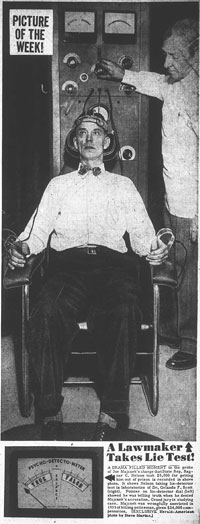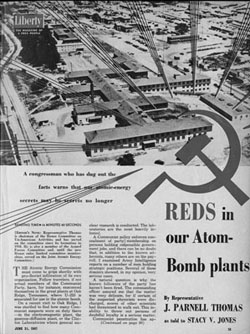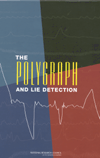THE ALL-AMERICAN POLYGRAPH
 |
Keeler’s cultivation of a commerical market for lie detection—first in insurance companies and banks, and then in all sorts of corporate settings—enticed many other competitors into the field of deception testing. Keeler’s nemesis was Dr. Orlando Scott, a Chicago alienist who promoted his own “brain wave detector.” Scott leveraged his medical qualification to pioneer to the introduction of lie detector evidence into civil cases, and he proved quite successful in selling his services to local firms. He also had a knack for publicity, though his “brain wave detector” was in fact nothing more than a galvanometer that measured sweatiness. Here he is in 1948 testing an Illinois state representative accused of extorting money from Joe Majczek, the real-life model for the story in Northside 777. |

| In 1946, in response to accusations that Soviet spies had infiltrated America’s nuclear facilities, Keeler and his “box” were brought down to Oak Ridge, Tennessee to safeguard America’s most potent weapon. He found no spies, but plenty of employees who had fibbed on their applications or believed in federally subsidized housing. In the process, Keeler transformed his device into a psychological deterrent and gauge of political loyalty. |
 |

 |
Between 1947 and 1953 some 18,000 residents of Oak Ridge were tested numerous times. Terminated as scientifically suspect, polygraph screening was reinstated at the nation’s nuclear weapons labs in 1999 in the wake of the (erroneous) accusations against Wen Ho Lee. These tests continue despite a 2003 report by the National Academy of Sciences entitled The Polygraph and Lie Detection, which suggested that this screening is ineffectual, harmful to morale, and a distraction from real security measures. In late 2006 the DOE had begun to reduce the systematic use of the polygraph on scientific personnel, though the agency persisted in arguing that random testing was needed as a “deterrent.” |
|